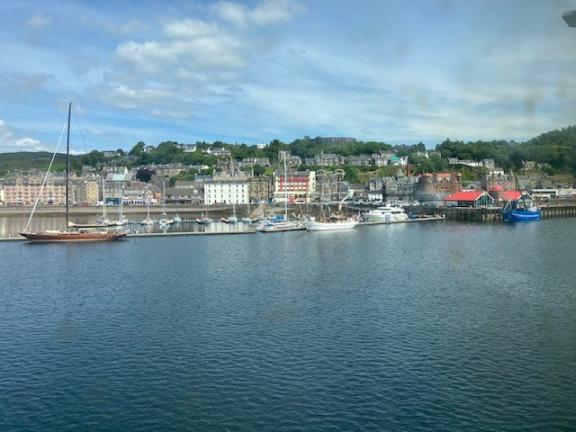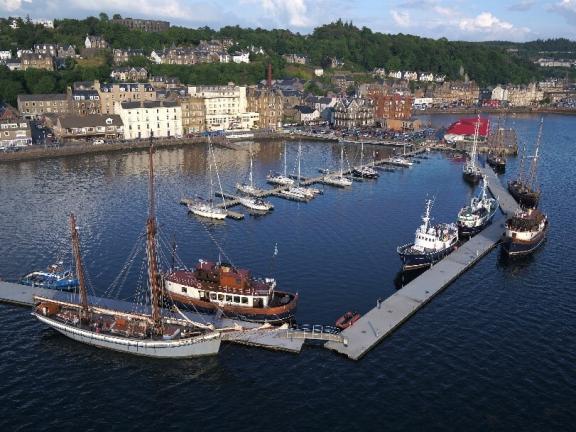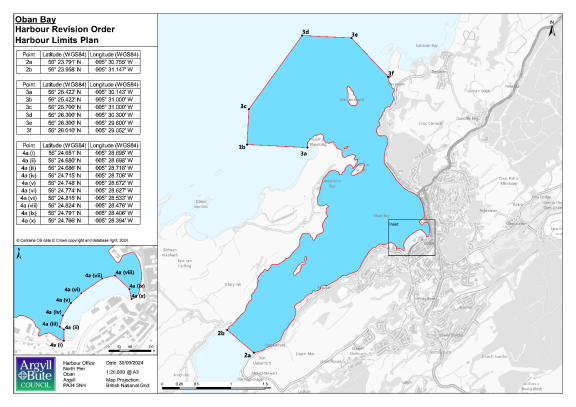
Brief background
The Council, CMAL/CalMac and the Northern Lighthouse Board have different responsibilities for areas of Oban Bay, and some parts of the bay are not part of the specific jurisdiction of any organisation – the situation is not ideal and can lead to confusion for users, with no organisation in sole control of the bay itself.
There are three separate Harbour Orders in place for Oban: the North Pier, Railway Pier and South Pier. The approaches and waters through the bay are not covered by an order. The responsibility for these waters defaults to the Maritime and Coastguard Agency (MCA).
Having one or more Statutory Harbour Authority controlling the entirety of the bay would remove any ambiguity and would likely result in benefits to users of the bay.
For a number of years, the Council with CMAL, CalMac, the Northern Lighthouse Board and various stakeholders have worked to progress a solution which would result in all of the bay, including the approaches, being covered by provisions which would enable the bay to be fully managed.
In 2018 CMAL were ready to progress a Harbour Order which would leave the Council’s North Pier ‘nested’ within a new Harbour Authority. The Council’s Harbour Board were satisfied with this arrangement. However, there was some concern expressed locally regarding CMAL becoming the new Harbour Authority and following discussions CMAL paused their process to allow a community group to explore the possibility of forming a Trust Port.
Whilst the community group had carried out a significant amount of work towards forming a Trust Port, the Council, in 2021, commissioned an independent third party to undertake an options appraisal to gain an independent view of the options available. The options appraisal reported that whilst there is no inherent reason why a Trust Port would not be a good option in the future, there was no Trust Port suitably well progressed, “a great deal of work remains to be done”. The Harbour Board considered the options appraisal at their meeting in December 2021

Decision of the Harbour Board December 2021
The Harbour Board at its 2 December 2021 meeting unanimously agreed the following 6 points:
- thanked Caledonian Economics for their work on the Options Appraisal;
- agreed that the Council would not at this time proceed with a transfer of assets on the basis that there were too many uncertainties around the proposal;
- noted that Options 4 or 5 (Argyll and Bute Council or Caledonian Maritime Assets Limited (CMAL) becoming the Harbour Authority for the unmanaged section of Oban Bay) provides a quicker route to addressing the current safety concerns and are therefore the best options available at this time.
- agreed that either Options 4 or 5 should move forward and request that Officers engage with CMAL, through the OBMG, on the basis that the Council’s preference would be option 5 and that the Council was prepared to be the Harbour Authority for the unmanaged section of Oban Bay, to begin the process of application for a Harbour Revision Order covering the unmanaged section of Oban Bay and to expedite the process for such an order and to report back to members on that process;
- noted that there was no inherent reason why a Trust Port would not be a good future option; and
- agreed that once Options 4 or 5 were delivered there would be a period of bedding in to monitor the new arrangement and, after that time, there would be a further report to members on the potential for and exploration of the future development of a Trust Port.
Current Position
Following that decision of the Harbour Board the Council is progressing a Municipal Port Authority for Oban Bay. This will include the approaches into the bay but exclude an area around the ferry terminal which will remain a separate Harbour Authority managed by CMAL. This will allow the Council to manage the wider Oban Bay to ensure that vessels follow the provisions which will be included in a formal Harbour Order.

"Oban Harbour" Project
The Harbour Revision Order (HRO)
The Council’s Harbour Board met on 31st August 2023 and approved a draft of the HRO for the formal application, assuming there were no material changes requested by Transport Scotland in the meantime.
The report clearly set out the key steps, including the 6-week consultation period consequential to that decision.
The process now follows these key steps:
| Step | Description | Actioned by |
|---|---|---|
| 1 | Formal application requested by Transport Scotland and submitted by Argyll & Bute Council. Accompanied by fee and supporting documentation | Transport Scotland and Council Officers |
| 2 | Public Notice – 42 days (6 weeks) of public consultation. May result in representations being received from members of the public, community groups or statutory consultees. | Objection handling by Transport Scotland by written representation, hearing or inquiry. Negotiation / modifications by Argyll & Bute Council. |
| 3 | Consultation with statutory consultees is also open for 42 days but may not exactly match the same commencement day as the public consultation period. (see 3.2.6) | Managed by Transport Scotland, then passed to Argyll & Bute Council. |
| 4 | Scottish Ministers consideration of application and decision. | Scottish Government. |
| 5 | Decision letter issued & decision published. | Transport Scotland. |
| 6 | Order Made. Argyll & Bute Council assume control of new harbour area. | Scottish Government. |
Following the successful conclusion of informal discussions, the formal application has now been submitted to Transport Scotland and the submitted draft can be read here -
Purpose and Effects (P&E) notes
Alongside the HRO itself, the Council has also collated a Statement of Support or ‘Purpose and Effect’ notes which is required with any HRO application. These notes lay out the reasonable justification for the powers a Harbour Authority needs as well as the effect those powers should have and can be read here -
Harbour Limits & Navigational Risk Assessment (NRA)
Assuming the process has been completed successfully and the Act is made, Argyll & Bute Council Statutory Harbour Authority area will be extended from the existing area round the North Pier. The new limits of ‘Oban Harbour’ will look like this:

The limits were underpinned by carrying out a Navigational Risk Assessment (NRA), which included summer and winter observation periods and extensive consultation with users and stakeholders.
The Northern limits include the ‘outside’ anchorages so that small tender vessels can be safely controlled while entering the Harbour.
The Southern limits include the Kerrera Ferry crossing so that approaching traffic can also be safely controlled.
The NRA itself can be read here -
- Oban Harbour Navigational Risk Assessment (NRA)
(Please note, this document may not be fully accessible for people using assistive technologies such as screen readers, please contact MarineAdmin@argyll-bute.gov.uk if you require this information in another format)
The Consultation
We would like to thank everyone who took the time to participate in the HRO consultation and the ongoing follow up process. Oban Harbour plays a critical role in the economies of Oban and the isles, through travel, tourism and business life. We want to improve safe and secure access to and from the town for all mariners, visitors and pleasure craft and will progress the HRO with that objective in mind.
The consultation closed on 10 January 2024 and each objector received a response with the Council’s position clarified and been asked whether they wish to withdraw that objection.
None of the public objections were withdrawn at that stage and Scottish Ministers determined that they would be handled by further written representations from both parties. Although there are no specified procedures in the 1964 Act for this, the timetable used in connection with objections under the Transport and Works (Scotland) Act 2007 (Applications and Objections Procedure) Rules 2007, which allows time for each party to respond were adopted.
Consultation Feedback including the Council’s position.
From this process, the Council received some 142 representations forwarded from Transport Scotland.
There were 6 from the ‘statutory’* consultees and 136 from other interested parties covering the key themes which are illustrated in the table below. There were 123 public representations that required a substantive reply.
*Note: As reported to the Harbour Board on 31 January 2024, the ‘statutory’ consultees, as listed on the Transport Scotland website, are:
- Scottish Environment Protection Agency (SEPA)
- Nature Scotland
- Northern Lighthouse Board
- The Royal Yachting Association Scotland
- Planning and Building Standards – Argyll and Bute Council
- UK Chamber of Shipping
- Maritime and Coastguard Agency
It is not usual to include Nature Scotland and SEPA, as the HRO does not include any new construction, however, Transport Scotland felt that due to the level of interest, it was prudent to inform them of the process as a matter of courtesy.
Further, although CFL and CMAL are not included in the statutory list, as public bodies with a special interest in the process, they were contacted directly to participate.
|
Subject |
Number |
% of total representations |
|---|---|---|
| Moorings |
78 |
63.4% |
| Finances / Accounts |
73 |
59.3% |
| Consultation |
59 |
48% |
| Council as Harbour Authority |
50 |
40.7% |
| Harbour Limits - Kerrera |
38 |
30.9% |
| Harbour Limits |
11 |
8.9% |
| Fees & Charges |
8 |
6.5% |
The Council replied to each of the representations directly and in responding to those issues have sought to clarify the Council’s position on the subjects raised, including those below that deal with the most common concerns.
Key Themes
While this is not an exhaustive list of the individual points, it is a summary of the key themes that arose from the consultation.
Moorings
The largest percentage of representations concerned moorings within the bay area and concerns over license charges and ownership. To manage moorings within the Argyll and Bute Council Harbour Authority areas a licensing system is required and is in operation. A properly licensed and consented mooring provides security of tenure for boat and mooring owners while protecting the interests of other marine users.
The Council has clarified that:
- Argyll and Bute Council as Harbour Authority will not take the role currently carried out by Crown Estates who are and will remain the owners and managers of the seabed in Argyll and Bute Council Harbour Authority areas.
- Licenses issued by Crown Estates for moorings are and will remain valid, irrespective of the Harbour Authority, whether for individual, commercial or mooring association administered moorings.
- There will be no charge made by the Harbour Authority for existing registered moorings. We recognise that owners have already applied for and maintained these licenses over a long period of time, and they pose no issue to safe navigation.
- Renewal of Crown Estates licenses for existing registered moorings will not be subject to any charge from the Harbour Authority.
- Any new mooring applications made to Crown Estates will normally be approved so long as there are no objections or conflict to safe navigation for harbour users i.e. maintaining safe and clear approaches to the bay. Any new applications will be subject to local consultation where feedback and safe navigation issues can be addressed. The Harbour Authority may charge for the administration of new mooring applications in the future.
- Conflicts of interest and objections can be raised, discussed and mediated through the fixed agenda item in the stakeholder user’s forum and with the Harbour Master. The Terms of Reference for these groups were approved through the Harbour Board on 31 August 2023.
The Council has also added the 'Moorings Policy', agreed by the Harbour Board on 21 March 2024, to the Marine Safety Management System.
Finance / Accounts
Representations also raised the matter of financial planning. The HRO provides that the Council prepare a statement of annual accounts each financial year and that requirement is in accordance with section 42 of the Harbour Act 1964.
The Council provides a copy of its accounts at its Chief office and on its website.
Consultation
While some consultees requested that consultation arrangements be contained within the HRO, it is not considered appropriate to do so on the basis that including these arrangements in the HRO would not allow for flexibility in managing and operating consultation with parties interested in the harbour over time.
The Council, as Harbour Authority for Oban Harbour, will have a continued commitment to consult with stakeholders as required by the Port Marine Safety Code.
The initial stakeholder terms and structure were approved by the Harbour Board on 31 August 2023 and are published on the Council’s web site and will form the new more flexible model for Oban Bay moving forward and the user group forums in our other marine locations.
Council as Harbour Authority
Some of the representations questioned the experience and ability of the Council to run the new Harbour Authority area.
The Council is already Statutory Harbour Authority at 8 locations, including at Oban North Pier, and a marine asset owner at a further 28 marine facilities located throughout the Council area. It carries out a range of duties and responsibilities described in the Port Marine Safety Code, health and safety, environmental and maritime legislation and guidance.
The Council is one of only c.14% of port managers, representing around 30% of Statutory Harbour Authorities that comply with the Port Marine Safety Code and manages these ports, harbours and piers as the Statutory Harbour Authority (SHA) and Local Lighthouse Authority (LLA).
The Piers and Harbours team can call on professional marine colleagues from a wide range of marine backgrounds and experience making the whole much greater than the sum of its parts.
Harbour Limits - Kerrera Marina area
Some of the representations objected to the area of Oban Bay occupied by Kerrera Marina and other moorings areas being included in the Harbour Authority area and therefore the jurisdiction of the Harbour Authority. However, the concept of a single Harbour Authority for Oban would see a single body as Harbour Authority, assuming responsibility for navigational safety throughout the bay area (except for the CMAL area) and it’s important that the coverage is as complete as possible. A patchwork of independent areas would seem counterproductive to the original aims which began this process.
The Council has sought to provide reassurance that the inclusion of Kerrera Marina and the other moorings areas ensures a cohesive structure for visitors and commercial customers alike with no jurisdictional issues from one area to another. It also provides continuity in matters such as oil spill response, enforcement of speed limits and control of anchoring.
In practice, Kerrera Marina will continue to deal with Crown Estates as it does now and since they already have moorings in place, we see no reason why there would be any changes, charges or interference from the Harbour Authority with their successful enterprise. Indeed, far from any conflict, we welcome the opportunity to build on the co-operation between the North Pier Pontoons and Kerrera Marina for the benefit of Oban and its sailing visitors and see Kerrera Marina as a partner in the Bay.
Harbour Limits
In the process of raising the HRO there was a requirement for a Navigational Risk Assessment (NRA) as part of the assessment process to understand the current level of marine risk and proposed mitigation for reducing the risk. This follows the requirements of the Port Marine Safety Code (DfT, 2016).
The NRA established a navigational baseline on which a data-based decision was made on the external limits of the Harbour. It is incumbent in applying for an HRO to justify any extension to the jurisdiction of its Harbour area in terms of improving safety for users and the data gleaned from the assessment fulfils that need.
During the consultation period CMAL pointed out an error in the positions at the boundary of the two Harbour Authority areas. The correction has been addressed in our response and Transport Scotland are aware of the error which we have asked to be addressed in their consideration of the HRO. The plan showing the extent of the HRO limits in the Bay does not change and the correction of the error does not result in any alteration or change to the extent of the area of bay area subject to the order.
Fees and Charges
The Harbour Authority will have an obligation to ensure open and safe use of the Harbour and is empowered to make reasonable charges for the running and maintenance of the Harbour. The authority to charge “ship, passenger and goods dues” as considered “fit” is vested in Argyll and Bute Council by the Harbours Act 1964 section 26(2) and applicable at all locations where Argyll and Bute Council is the statutory harbour authority and exercises its statutory harbour powers in accordance with its governing legislation. There is no plan to exclude CFL ferries from charges and in fact the charging strategy has a specific rate for the CalMac ferries included.
The monies raised from levying harbour dues are primarily used to maintain the harbours and to provide for their long-term viability and encompasses, 'ship, passenger and goods dues', namely those charges associated with:
- Ships entering, using or leaving the harbour.
- Passengers embarking or disembarking at the harbour.
- Goods brought into, taken out of, or carried through the harbour by ship.
The Harbour Board agreed on 31 January 2024 to recommend to Council, in the event that the HRO is made, that the following categories of craft should be exempt from payment of ‘conservancy’ charges but may still be liable for berthing or combined charges at berths within Oban Harbour Authority area:
- No charges will apply to vessels which are involved in an ongoing emergency.
- Commercial and pleasure vessels under 50 GRT.
- Fishing vessels.
- Tenders used to access another vessel in the vicinity of harbour or facility.
- Canoes / kayaks.
- Personal watercraft (Jet Ski etc.).
- Sail / paddle boards.
Statutory Consultees
In addition to the public responses, the Council had positive engagement with the bodies contacted directly, including with RYAS and CMAL who both raised points of interest on several themes. Objections have been withdrawn from these consultees except for:
RYAS, who wish to maintain their objections pending sight of a fully revised draft of the Order.
Transport Scotland will consider all submissions made during the consultation and the phase of further engagement that followed.
The following summarises the points which the Council have highlighted to Transport Scotland for consideration by them, as these may be beneficial in clarifying matters in the order while having no material impact on the fundamental nature of the order itself.
Ultimately, it is for Transport Scotland to advise Scottish Ministers and for Scottish Ministers to make a final determination regarding the terms and status of the Order.
In Part 1, which lists the definitions of terms that are used in the HRO:
- Removing "sections and elevations" from the definition of "deposited plans" because this will avoid any confusion with an HRO dealing with new construction.
- The definition used for “harbour premises” to include the clarification that it refers to items that are “within the harbour limits”.
- In case the names of the services change in future, to include the phrase, "or any similar replacement service” in the definition of ferry services and amend the definition of "CMAL" to include any successors to CMAL as owners of the railway pier.
In Part 2, which is the body of the order split into sections:
- The corrections provided to the co-ordinates for the railway pier Harbour Authority area, and to specifically exclude the railway pier from the harbour limits as this will correct the error in coordinates, clarify and simplify the descriptions of the respective Harbour Authority areas.
- Clarify that the HRO will not prevent access to the adjoining Harbour Authority area except if in an emergency so that the adjoining Harbour Authority can have reassurance that their interests and obligations will not be impaired unfairly.
- Since there is an appointed Harbour Master with Assistant Harbour Master support, the term “duly appointed officer of the Council” to be removed to avoid confusion or ambiguity.
- Clarify that as carparks are not in the harbour undertaking, the reference to “Parking Places” has no effect. Car parks are operated by the Council under different legislation.
- Clarify that the HRO is not attempting to alter the liability of shipowners, when dealing with damage caused by vessels.
- Clarify Harbour Authorities are required to publish notification of any new moorings or structures and that safe passage to operational berths is protected from any new moorings.
- Clarify the publication and availability of the Council’s accounts.
In Part 3, which deals with harbour regulations
- Clarify that there are no existing bylaws that affect the Harbour Authority area.
- The word “Scotland” should be added to the designation of Royal Yachting Association as the body to be consulted on for “General Directions”.
- For clarity, the phrase, “and in order to promote or secure conditions conducive to the ease, convenience or safety of navigation or the safety of persons” should be added to the preamble for general directions.
- The phrase, “or other emergency” added to “seeking refuge from stress of weather”, to clarify that in poor visibility that would possibly result in a harbour closing for safety, vessels will not be denied entry if in difficulty.
In Part 4, which deals with financial provisions:
- The phrase “or any other vessel” is added to the definitions describing things that are not a ship as legally defined but should still be liable to pay dues and charges.
- As in a previous clarification the word “Scottish” to be added to “Ministers” when describing government officers that are exempt from charges.
- Also, for clarity the term “limits of the harbour” to be replaced by “harbour limits”.
- Amend article 36 to remove any risk of misinterpretation that operating ferries passing through the harbour limits to and from the railway pier are not exempt from liability for charges.
In Part 5, dealing with miscellaneous provisions:
- Clarification that nothing in this HRO should interfere with the rights CMAL have from their own legislation.
- Finally, and in regard to the older and existing legislation covering the harbour areas, confirmation has been presented to Transport Scotland that CMAL is content for sections 40 to 42 of the Callander and Oban Railway Act 1878 ("the 1878 Act") to be repealed, together with the entirety of the Oban Piers Order 1896 (contained within the Piers and Harbour Orders Confirmation (No. 5) Act, 1896) ("the 1896 Order")
The amendments proposed by CMAL amount to a repeal of largely superseded or inactive legislative provisions and do not have any material effect on the fundamental nature of the HRO.
None of the matters highlighted above materially alters the character of the order but rather help to clarify the intent of the specific sections affected.
Scottish Ministers decided that the remaining objections to this order should be dealt with by way of written representations, as provided for within the Harbours Act 1964.
During the remainder of this process, there is no new or redrafted order, instead, the original draft order is reviewed by Ministers and Transport Scotland having regard to the objections and representations received.
Questions and Answers
Q1. Does the Oban Bay Management Group support the Municipal Harbour?
The concept of the municipal harbour has been supported by all members. The subsequent views expressed by some members are in respect of the detail of the HRO and wider governance matters.
Q2. Oban is a distinct and complex harbour; how can we be confident that Argyll and Bute Council has the expertise to run it?
Argyll and Bute Council has a Harbour Master at Oban with a great deal of experience both in general marine terms and specifically in managing Oban Bay. Oban Bay is one of 36 piers and harbours managed by Argyll & Bute Council, including seven Statutory Harbour Authorities one also being a Competent Harbour Authority. Within the Roads and Infrastructure Services, the Marine Department have an extensive range of experience supported by (among others) Legal, HR & Technical Design colleagues.
Q3. What will the staffing be and what hours will the Harbour operate?
The Harbour will operate between 06:00 and 23:00 with three Assistants working with the Harbour Master to cover the ferry timetable periods.
Q4. How will Argyll and Bute Council govern the harbour and ensure the local community and stakeholders are involved?
Argyll and Bute Council’s piers and harbours are operationally managed by the experienced marine team mentioned above. The Council has a Harbour Board comprised of Elected Members from across Argyll and Bute – the Harbour Board sets and scrutinises the delivery of policy in relation to the Marine service area.
We also have harbour user/stakeholder groups across the area which meet regularly – this arrangement will be replicated in Oban.
Q5. Will the extra charges discourage visitors and where will any profits go?
Argyll and Bute Council will receive most of its income from fees and charges from larger vessels and CalMac (CFL), whereas locals and local business will benefit from any developments made to encourage visitors to Oban. Conservancy charges etc. made on non-leisure craft are to cover the costs of maintaining the port and the duties required of the Harbour Authority (whomever that may be) in keeping the Port safe and open for business.
Q6. Are there any plans for upgrading the port facilities?
There are plans at an early stage which look at an extension of the North Pier. The scope of the proposal would include extending and strengthening the North Pier by up to an additional 50m and dredging to a usable uniform depth of 5m to facilitate and future proof the berthing face for commercial customers. The works would help to ensure a safe and efficient through traffic management of commercial and private vehicles using the pier.
This is a valuable strategic asset to Argyll and Bute and is in high demand from commercial vessels. An increased berthing capability would provide a greater number of options, and would continue to support key sectors like aquaculture, while at the same time providing increased landing capability for salt deliveries which are used to maintain our winter salt stocks and ensure that Argyll and Bute remains open for business.
Q7. Why do we need any change, surely existing COLREGS are enough for safety?
The formal management of the larger bay area allows the Harbour Authority to enforce legislation (like COLREGS) and other safety rules (like speed limits). Without the inclusion of the larger bay area in a new HRO, there is the possibility of disruption or incidents which take place outside the jurisdiction of the existing Authorities. Local leisure and regular users should not notice much of a difference in the day-to-day running of the Bay.
Q8. Will the harbour eventually be transferred to CMAL or run for the benefit of CalMac ferries?
Oban Bay is recognised as an important strategic asset within Argyll & Bute. The Council will run and maintain Oban Harbour with a long-term outlook.
Q9. Will small leisure craft still be able to launch for free and have access to the bay?
Argyll and Bute Council operates an ‘Open Port’ policy which ensures that safe access and safe use of our Ports and Harbours is enjoyed by the public. Leisure craft will be exempt from Conservancy Fees.
Q10. What is the process for modifying the draft order? Can we comment on a new draft order?
Any modifications to pick up drafting errors, to meet objections or provide clarifications are not considered to substantially affect the character of the Oban order and are presented to Transport Scotland and the Minister for decision. There is therefore no ‘new’ consultation or draft order however, any modifications or mitigations accepted for inclusion have been communicated with those who raised the point in their representation.
Q11. Does the council have the expertise to become a municipal harbour authority?
Yes. Argyll and Bute Council is a Statutory Harbour Authority at seven locations and a marine asset owner at a further 29 marine facilities located throughout the Council area, operates 4 ferry services and has an extensive team of Harbour Masters, mariners, design engineers with marine specialisms, lawyers, accountants, back-office support, a diverse management team and a multi skilled executive team which provides leadership support. Oban Municipal Harbour will simply be an extension of existing business, benefiting from the systems, expertise and organisational backing that is already well established and in place.
Q12. Will there be a speed limit within the Bay?
Yes. All vessels are required to proceed at a safe speed but to clarify and prevent accidents or damage the present 10 knots and 6 knots speed limits work well.


